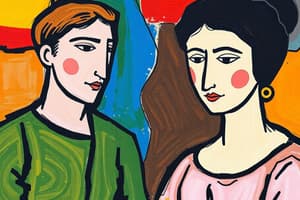Podcast
Questions and Answers
What does the term 'maniera' mean in Italian?
What does the term 'maniera' mean in Italian?
- Realism
- Naturalism
- Classicism
- Stylishness (correct)
Where did Mannerism originate?
Where did Mannerism originate?
- Milan, Italy
- Florence, Italy (correct)
- Venice, Italy
- Rome, Italy
What did Mannerist artists emphasize in their work?
What did Mannerist artists emphasize in their work?
- Realistic portrayal of subjects
- Traditional conventions and techniques
- Individual way of painting and personal vision (correct)
- Use of grayish tones in paintings
How did Mannerist artists portray human figures in their artwork?
How did Mannerist artists portray human figures in their artwork?
What type of perspective did Mannerist paintings typically use?
What type of perspective did Mannerist paintings typically use?
Who created the artwork 'Madonna with Long Neck'?
Who created the artwork 'Madonna with Long Neck'?
What is the origin of the word 'Baroque'?
What is the origin of the word 'Baroque'?
What artistic theme is prominent in the Baroque period?
What artistic theme is prominent in the Baroque period?
What technique is used to achieve chiaroscuro in Baroque paintings?
What technique is used to achieve chiaroscuro in Baroque paintings?
Who designed the San Carlo alla Quattro Fontane, experimenting with complex geometric designs?
Who designed the San Carlo alla Quattro Fontane, experimenting with complex geometric designs?
Which country is known for its distinct style of Rococo art characterized by elaborate artworks aimed to please rather than instruct?
Which country is known for its distinct style of Rococo art characterized by elaborate artworks aimed to please rather than instruct?
Who is considered the Father of Rococo Art?
Who is considered the Father of Rococo Art?
What type of room was a major innovation in Rococo architecture for entertaining guests?
What type of room was a major innovation in Rococo architecture for entertaining guests?
Which composer is not associated with Baroque music?
Which composer is not associated with Baroque music?
'Chiaroscuro' in painting is achieved by contrasting which elements?
'Chiaroscuro' in painting is achieved by contrasting which elements?
What does the term 'rocaille' mean in relation to Rococo art?
What does the term 'rocaille' mean in relation to Rococo art?
Flashcards
Mannerism
Mannerism
A reaction to the High Renaissance, emphasizing artificiality, emotional intensity, elongated figures, and distorted proportions.
Baroque Art
Baroque Art
Art style characterized by grandiosity, drama, theatricality, and the use of chiaroscuro.
Baroque Architecture
Baroque Architecture
Architectural style characterized by ornate complexity, often breaking from the Renaissance's simplicity.
Rococo Art
Rococo Art
Signup and view all the flashcards
Rococo Architecture
Rococo Architecture
Signup and view all the flashcards
Chiaroscuro
Chiaroscuro
Signup and view all the flashcards
Maniera
Maniera
Signup and view all the flashcards
High Renaissance
High Renaissance
Signup and view all the flashcards
Worm's eye view
Worm's eye view
Signup and view all the flashcards
Baroque Music
Baroque Music
Signup and view all the flashcards
Rocaille
Rocaille
Signup and view all the flashcards
Antonio Vivaldi
Antonio Vivaldi
Signup and view all the flashcards
Study Notes
Mannerism
- 'Maniera' in Italian translates to 'manner' or 'style'.
- Mannerism originated in Italy during the late 1520s and early 1530s as a reaction against the High Renaissance.
- Mannerist artists emphasized artificiality, elegance, and emotional intensity in their work.
- They often elongated figures, contorted poses, and distorted proportions to create a sense of unease and drama.
- Mannerist paintings typically used a complex system of perspective called 'worm's eye view', where the viewer feels as if they are looking up at the scene.
- 'Madonna with Long Neck' (c. 1534) was painted by Parmigianino.
Baroque
- 'Baroque' originates from the Portuguese word 'barroco', meaning 'irregular pearl'.
- Baroque art is characterized by grandiosity, drama, and theatricality.
- The artistic theme of 'theatrical' is prominent in the Baroque period, with paintings often depicting scenes of religious fervor, violence or triumph.
- Baroque artists used the technique of chiaroscuro, which is the use of light and shadow to create dramatic effects.
- Francesco Borromini designed the San Carlo alla Quattro Fontane, known for its complex geometric designs that break away from Renaissance simplicity.
Rococo
- Rococo art, particularly prevalent in France, is characterized by elaborate, elegant designs and a focus on pleasure and amusement rather than moral instruction.
- Rococo originated in early 18th-century France and characterized by ornate decorations and pastel colors.
- Jean-Antoine Watteau is considered the Father of Rococo Art.
- Rococo architecture introduced the 'salon', a large, ornate room designed for entertaining guests.
Baroque Music
- Antonio Vivaldi is not associated with Baroque music. He is known for his contributions to the Classical period of music.
- 'Chiaroscuro' in painting is achieved by contrasting light and dark elements.
Rococo Art
- 'Rocaille' is a term used to describe the ornate, curvilinear ornamentation that is characteristic of Rococo art.
Studying That Suits You
Use AI to generate personalized quizzes and flashcards to suit your learning preferences.




